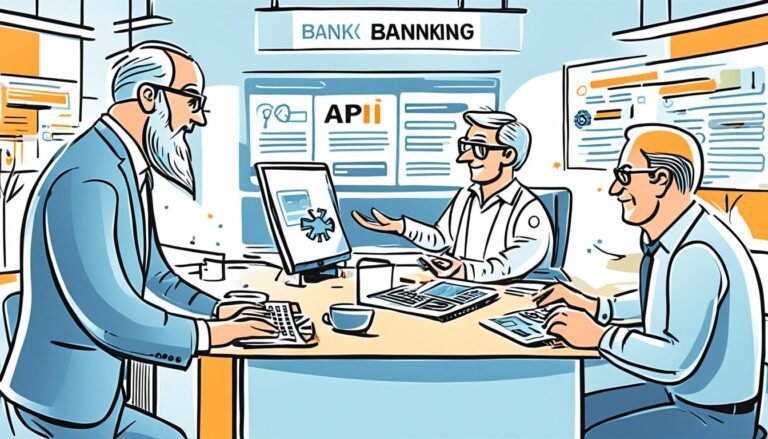The Future of Payments: Cryptocurrency and Digital Wallets
Did you know the global digital payments market could reach $12.55 trillion by 2027? This huge number shows how money is changing. From simple trade to using digital wallets and cryptocurrencies, we’re seeing big shifts. These changes offer more convenience, safety, and will be more efficient.
Looking at cryptocurrency and digital wallets, we see a major change. It’s not just exchanging money anymore. These new tools are shaping how we see and use money. With mobile tech and the internet growing, we’re finding more new ways to pay.
Key Takeaways
- The global digital payments market is projected to reach $12.55 trillion by 2027.
- Digital payment solutions offer unprecedented convenience, security, and efficiency.
- The evolution of money includes the shift from bartering to the use of cryptocurrencies.
- Cryptocurrencies and digital wallets are redefining how we transact and perceive money.
- Technological advancements continue to drive the innovation of payment systems.
Introduction to Cryptocurrency and Digital Wallets
Financial transactions have changed a lot. Now, we use digital currency and digital wallets. Cryptocurrencies like Bitcoin and Ethereum use a special technology called blockchain. This makes money safer and more open. It’s way different from regular money because it’s not controlled by just one place.
Digital wallets are tools for handling digital currency. You can get them as apps or physical devices. They make it easy to manage your cryptocurrencies. You can send, receive, or save money without a bank. This means you can do money stuff all over the world without waiting.
Cryptocurrency benefits include lower costs and faster transactions. This is a big change from regular banks, which often ask for a lot of fees. Cryptocurrencies make sending money cheaper and quicker. This is good for many reasons.
Let’s look at how traditional banking and cryptocurrencies compare:
| Aspect | Traditional Banking | Cryptocurrency |
|---|---|---|
| Transaction Speed | Several Days | Minutes |
| Transaction Fees | High | Low |
| Global Reach | Limited | Immediate |
| Security | Centralized | Decentralized |
Choosing digital currency and digital wallets makes finance better for everyone. They promise safer, clearer, and faster money moves. This is good news for places that are growing or already have a lot of money.
Blockchain Technology and Its Impact on Payments
Blockchain is seen as the heart of cryptocurrency. It uses a decentralized ledger to track transactions on many computers. This makes it a big step forward in how we make payments.
The Basics of Blockchain
At its core, blockchain is a decentralized ledger. It ensures that transactions are clear and open to everyone. Each transaction becomes a block, linked in order, creating a chain. This design greatly boosts security since it’s very hard to change any past transactions without changing every block that comes after.
Key Advantages of Blockchain in Payments
Using blockchain in payments has several pluses. It:
- Blockchain security: Makes data very secure against fraud.
- Speed: Lets transactions wrap up in minutes, not days.
- Transparency in transactions: Lets everyone see the transaction details. This cuts down on mistakes and fraud.
Potential Challenges and Limitations of Blockchain Technology
However, blockchain does have its hurdles to overcome:
- Scalability: It can be hard for blockchain networks to keep up with a high volume of transactions at once.
- Energy consumption: Keeping blockchain secure takes a lot of energy.
- Regulatory acceptance: Getting everyone to agree on how to regulate blockchain is also tricky.
Decentralized Finance (DeFi) and Its Role in Payment Systems
Decentralized Finance (DeFi) is a big deal in the world of cryptocurrency. It refers to financial apps on blockchain networks. They make financial services more open and reduce the need for middlemen. Uniswap and Compound are popular DeFi platforms changing how we see money and investments.
What is DeFi?
DeFi stands for Decentralized Finance. It aims to make financial systems open and easy for anyone online. At the heart of DeFi are smart contracts. These are like digital agreements that run without needing a person to check them. Because of this, DeFi cuts out the middleman, giving us more control over our money.
The Role of DeFi in Facilitating Transactions
Smart contracts on DeFi platforms make transactions smooth and secure. They do this by enforcing the agreement automatically. This means we don’t always need banks for our money moves. And it makes things cheaper too. DeFi has the power to change finance by making transactions clear and open everywhere.
Examples of DeFi Platforms in Use Today
Some DeFi platforms are already making a big difference. Let’s look at a couple:
- Uniswap: It’s a decentralized exchange where you can swap cryptocurrencies straight from your wallet. It uses liquidity pools for trading.
- Compound: This platform lets you lend and borrow digital coins through smart contracts. By doing this, you can earn interest.
These examples show how DeFi is shaking up the world of money transactions. They bring new ways to manage assets and focus on making finance fair and efficient for everyone.
Peer-to-Peer Transactions: A New Era of Payments
The world of payments is changing with P2P transfers. This new tech lets us send money to friends or family directly. It’s now easier and faster to pay others without going through banks.
The Evolution of Peer-to-Peer Payments
The internet’s growth has changed how we manage money. P2P payments have been a big leap in digital transactions. Now, sending money is instant and doesn’t need a middleman. This change has been made by new fintech, focusing on making things better and simpler.
Advantages of Peer-to-Peer Transactions
These direct payments have many plus sides over traditional banking:
- Lower Costs: They often cost less, which helps save money.
- Simplicity: User-friendly P2P apps make it easy for everyone to use.
- Speed: Sending money happens fast, good for urgent payments.
Popular Peer-to-Peer Payment Platforms
Some apps are leading the way in P2P payments:
- PayPal: Known everywhere, it connects people globally.
- Venmo: It’s a hit in the U.S., especially for its fun app feel.
- Zelle: Allows swift bank transfers within the U.S.
These services show how P2P payments are now a key part of how we manage money. They work smoothly in daily life, on both computers and phones.
The Future of Payments: Cryptocurrency and Digital Wallets
The future will bring new ways to pay, making our financial world change. Technologies like AI and IoT, linked with cryptocurrency and digital wallets, will make paying easier and safer.
More secure ways to pay will make us not rely on cash. With better tech and fraud spotting, trusting digital payments becomes easier. This is good for both people and companies, making payments fast and secure.
Our digital payment future will focus on technology and being accessible for all. Digital wallets are getting better, offering quick payments, low fees, and being useable worldwide. This will help more people use them.
Advantages of Cryptocurrency and Digital Wallets:
- Enhanced Security: Advanced encryption and decentralized networks reduce the risk of fraud.
- Lower Costs: Minimal transaction fees compared to traditional banking systems.
- Global Accessibility: Seamless transactions across borders without the need for currency conversion.
- Convenience: Digital wallets provide an all-in-one platform for managing multiple currencies and financial services.
Change to digital payments is coming, with more people and shops using new ways to pay. This move will make our money world better, easier, and open to all.
The Rise of Mobile Wallets and Contactless Payments
Mobile wallets are now highly popular because of their convenience and efficiency. People are looking for quick and safe ways to pay. This has made apps like Apple Pay, Google Wallet, and Samsung Pay very well-known for changing how we pay every day.
The Popularity of Mobile Wallets
The use of smartphones plays a big role in the growth of mobile wallets. These wallets keep all your cards in one spot, making carrying them around unnecessary. This makes buying things easier. Shops are now using systems that work with these mobile wallets, which helps spread their use even more.
The Technology Behind Contactless Payments
NFC technology is key to contactless payments. It lets your phone talk with a payment machine very easily. You just need to tap your phone to pay. This same tech is also used for other things, like sharing information and getting into secure places.
Future Trends in Mobile Payments
Mobile payments are only going to get more popular, and we’re already seeing some new trends. For example, mobile wallets are starting to add loyalty programs and finance management tools. This makes people use them more. Another big thing coming up is using blockchain for payments, which could mean payments are even safer and quicker.
| Trend | Impact |
|---|---|
| Loyalty Programs Integration | Encourages frequent use and engagement |
| Personal Finance Tools | Helps users manage spending and savings |
| Blockchain-Based Systems | Enhances transaction speed and security |
Financial Inclusion through Digital Currency Adoption
Digital currency can greatly help invite more people into the financial world. By using new technology, we can offer banking services to those left out before.
Challenges of Financial Inclusion
Yet, many challenges remain that prevent financial inclusion. One big issue is the lack of strong internet for everyone. Also, we need to teach people about finances so they can use digital services well. We must solve these problems to move forward.
The Role of Digital Currency in Bridging the Gap
Digital currency is excellent for helping more people join the financial world. It makes transactions safe and cheap for anyone, no matter where they are. This gives people the power to handle their money better.
Success Stories of Financial Inclusion Using Digital Currency
Some places have already seen great results from using digital currency. In India, the Unified Payments Interface (UPI) changed how people manage their money, helping millions. Digital money has also made sending money in developing countries easier and cheaper.
| Country | Platform | Impact |
|---|---|---|
| India | Unified Payments Interface (UPI) | Millions gained access to financial services |
| Kenya | M-Pesa | Increased financial transactions and saving rates |
| Philippines | GCash | Enhanced access to banking for rural communities |
Regulatory Landscape and Cryptocurrency
Cryptocurrency is becoming more accepted worldwide. This makes the regulatory landscape change. Governments are creating laws to deal with cryptocurrencies in ways that ensure market stability and protect investors, adapting to new technologies and demands.
Current Regulatory Approaches
Leading countries are building strict legal frameworks for cryptocurrencies. The USA, Japan, and Germany have detailed rules. They focus on things like KYC and AML to keep their markets clean. Meanwhile, China has chosen to ban crypto to control its financial sectors more effectively.
Impact of Regulations on the Crypto Market
Regulation can hugely impact the crypto market. Good rules make the market safer, encouraging trust and growth. But if rules are too harsh, they might slow down or push the market into the shadows, making people believe it’s not safe.
Future Regulatory Trends and Expectations
The crypto market’s growth will push regulations to change. The aim is to make a balance between risks and encouraging new ideas, all while making the market safer. This involves working together globally and creating new rules as technologies like DeFi and NFTs continue to grow.
| Country | Approach | Impact on Market |
|---|---|---|
| United States | Comprehensive regulations (KYC, AML) | Positive market stability, increased investor protection |
| Japan | Regulated exchanges, investor safeguards | Enhanced market trust, innovation support |
| China | Complete ban | Suppressed market growth, reduced crypto activities |
Cybersecurity Concerns in the World of Digital Payments
Today, digital payments are on the rise. It’s critical to have strong cybersecurity in place. People worry about protecting their information, making safe online purchases, and avoiding fraud. Let’s explore the key aspects of keeping digital payments secure.
Common Cybersecurity Threats in Digital Payments
Cyber threats are a big problem for digital payments. These can lead to leaks of private data or unsafe online deals. Attackers may cause:
- Hacking: This means crooks can break into payment systems, causing money loss and data theft.
- Phishing: Scammers send fake emails and make websites to get people to reveal secret info.
- Malware: Bad software can get into your devices, stealing personal data and making illegal transactions.
Measures to Enhance Security in Digital Transactions
It’s important to beef up security to tackle these threats. Here are ways to make sure your data is safe and transactions are secure:
- Encryption: This scrambles your info so bad actors can’t read it.
- Multi-factor Authentication (MFA): Requires more than one check before letting you in, adding a strong layer of protection.
- Constant Vigilance: Watching for strange activities can stop fraud before it happens.
The Future of Cybersecurity in Digital Payments
As we go forward, experts plan to use advanced AI and blockchain. These new tools aim to stop fraud before it starts. This would make online buying even safer.
Conclusion
Cryptocurrency and digital wallets play a huge part in changing how we pay. They make payments easier and safer in our digital world. This change is happening fast.
Blockchain, DeFi, and P2P transactions show how finance is becoming decentralized and open. As we use mobile wallets and make contactless payments, the trend for easy and accessible finance grows. We’re moving towards a future full of smooth digital money moves.
Digital currencies are pushing for more people to join the financial world. But, we must keep our money safe online. Solving these issues is important for these new ways to succeed. The future of finance is bright. Payment changes will keep making our digital money life better and safer.








